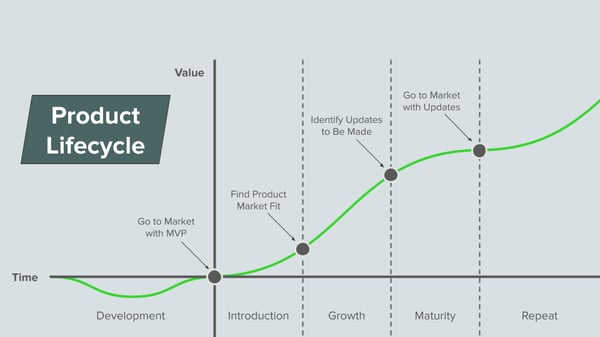Understanding the 4 Stages of the Product Lifecycle
There’s often a common thread shared between small startups on their way to their first product launch and major scaling companies releasing their latest product update. The commonality is this: Both businesses have a product they’re working to market and sell.
Every single product goes through a series of changes over the course of its lifetime. A product's lifecycle has four distinct stages that range from its earliest idea stage to its end of life. Understanding these four product lifecycle stages, alongside the preliminary stage zero, can help you create a successful plan for launching a new product or improving the performance of an existing one.
It can also help you recognize when your product is ready to move on to the next stage. This will help you forecast how they will impact your business. Neglecting to forecast how a product’s life will play out can make the difference between the companies that succeed and those that fail.
The four primary stages every product goes through are Introduction, Growth, Maturity, and Decline. Before a product even enters the introduction stage, it has to be developed. We consider this stage zero.
Stage 0 — Development: Minimum Viable Product (MVP)
All products start out as ideas. Before an idea goes from concept to development, it’s key to take time to conduct market research. A strong understanding of the market you’re going to be selling to provides advantages that you can use in the development stage. Find out the answers to questions like:
-
Which needs are you addressing?
-
Who are your primary competitors going to be?
-
How will you differentiate yourself in the minds of your target customers?
Addressing these questions is a critical component to offering a better product because investing time and money into developing a product that has no real viability is a huge waste.
Once your prospective product enters the development stage, your goal should be to reach a minimum viable product (MVP). This means that the product has enough features to satisfy the target market you plan on introducing it to, so you can gain feedback from early customers. By no means does your product have to be perfect. It just has to reflect the biggest capabilities it’s meant to offer, so customers can provide key feedback that will influence product iterations and updates.
Stage 1 — Introduction: Realizing Product-Market Fit
The introduction stage marks the beginning of a product's lifecycle. Once you have developed a minimum viable product that offers basic functionality, you need to be ready to bring it to market. As mentioned, this means you need to be prepared to launch a product that may need adjustments based on the feedback from your audience.
Reid Hoffman, the founder of LinkedIn, once said, “If you’re not embarrassed by the first version of your product, then you launched too late.”
It’s more valuable to introduce a product early and learn from its mistakes than it is to wait until it’s perfect and expect immediate returns. Doing this will help you reach the goal of the introduction stage, which is to achieve product-market fit. Waiting for the “perfect product” doesn’t give you the key insights needed to make the product perfect. Early introduction and getting feedback from customers will help you develop your new product in ways that you may not have come across on your own.
The Masters of Scale episode titled “Handcrafted” with Reid Hoffman illustrates this perfectly. In it, Brian Chesky of Airbnb discusses a conversation he had with Paul Graham, Co-Founder of Y-Combinator, a start-up incubator, which cultivates and invests in early-stage companies.
Paul encouraged Brian to go out and meet every single one of Airbnb’s customers while they were still small enough to do so. That way they could get to know them, learn from them, and build a product directly for them.
Obviously, this is not a process that will scale as it would become increasingly more costly, but in its current state, these check-ins could uncover valuable insights that may influence and change certain capabilities. This set Airbnb up for success when the company entered the next product lifecycle stage, growth.
Strategy to Consider During the Introduction Stage
During the introduction stage, companies should focus on product promotion in order to generate awareness and interest. There are many different ways you can generate demand for your new product. One way is to implement a thoughtfully-planned paid strategy to get the word out. Do this by creating and promoting content through these paid initiatives that your target buyers would find valuable and informative.
Other ways to promote your products are on social media, at in-person events, and by offering special deals that will entice your target audience to make a purchase and leave feedback on what could be improved.
Stage 2 — Growth: Achieving Economies of Scale
Each lifecycle stage builds on the foundation provided by the last phase. The customer feedback previously provided is meant to be used to make improvements and innovations to products. After Airbnb spent time with their customers to understand what they liked and what they thought could be better, they used this information to continue building a great experience that their existing and future customers would love.
Their devoted customer base of evangelists made it easy for Airbnb to increase public awareness and generate demand. This enabled them to penetrate the market and achieve rapid growth.
Using this time to generate demand by launching new campaigns that emphasize the value of new product updates will help you achieve the kind of growth you hope for. It’s also important to focus on improving customer service during this stage to ensure your product is meeting customer needs and satisfying users.
With your product reaching the end of any new major fundamental changes, the amount of time and money invested in product development will significantly reduce, and focus will begin to shift to reaching economies of scale. This is typically when companies receive Series B or Series C funding that is used to invest in marketing and sales to reach a mass market.
Entering new markets and expanding into international markets will help capitalize on the growth opportunities that present themselves.

Strategy to Consider During Market Growth
You’ve got the demand, but do you have the supply to fulfill it? During the growth stage, businesses should implement strategies and find ways to reduce cost or increase production in order to maximize profits. Take a look at your current business processes and see what could and should be improved. Could your production line run more efficiently? Are there outsourcing opportunities that would help reduce product cost? Spend time evaluating and identifying gaps in your production strategy that you could improve in order to fuel productivity and profitability.
Stage 3 — Maturity: Brand Differentiation
The maturity stage is when a product gains maximum market penetration. During this stage, sales and profit growth begin to level out as efforts to expand outreach are exhausted. As these efforts decrease, so does cost, allowing companies to achieve economies of scale. Unfortunately, this does not mean that growth gets any easier.
To counteract the negative impacts of the maturity stage, remain profitable, and avoid entering a decline, focus on retaining existing customers while minimizing marketing costs. This can be done through the introduction of loyalty programs and other promotions that benefit your customers.
One of the most influential things you can do is differentiate your product and brand from the competition through product enhancement or a change in strategy. Salesforce’s CEO Marc Benioff has stated that your brand is your most important asset.
Your competition can and will duplicate the features of your products, but they cannot replicate the way people identify with your brand and your personality. This differentiation creates loyalty and prevents emerging competitors from stealing customers.
By this point, you’ve proved that you have a successful product — and for every product that succeeds, there will be multiple attempts to duplicate it. This increased competition forces prices down, which reduces profitability. With the tactics above, you can differentiate yourself from those that mean to secure some of your target market, and so you can ensure your product is at a level higher than the competition.
Strategy to Consider During the Maturity Stage
By this point, your product has penetrated the market and sales are consistent. This doesn’t mean you should slow down your promotional strategies and continuous product improvements.
During this stage, leaning into technological advances and working to improve customer service will help differentiate your products from competitors. It is also wise to administer a customer retention strategy that keeps your current customers happy and involved with news and product updates.
Build brand loyalty and focus on creating lasting relationships with your customers so they don’t feel the need to switch to another similar product or copycat. Reward them for being loyal to your brand and take those small extra steps to make them feel proud to support you.
Stage 4 — Decline: A Product's End of Life
All good things must come to an end, and the decline stage marks the beginning of the end of a product’s lifecycle. As demand falls and market saturation begins to set in, sales and profits become more of a logistical challenge. This is either because of competition or changes in user preference. This can lead to drastic measures such as reduced production costs, existing unprofitable markets, and price cuts.
In this stage, it is important for companies to make wise decisions regarding their product. Incorrect moves could lead to major losses or a financial downturn that marks your product for early retirement. Unfortunately, this stage will be unavoidable for every product, but not for every company.
Every product in its current state will grow, mature and decline, but a company can update its existing products to meet current needs, add new, up-to-date features, or introduce entirely new products to avoid succumbing to the same ailments afflicting its declining products. Doing this restarts the product lifecycle and ensures that the company lives on.
Strategy to Consider During the Product Decline
When your product reaches the decline stage, there are still strategies you can put into effect to reduce losses from a dip in demand. Focus on cost cutting measures, such as leaving certain markets or discontinuing underperforming products.
Take a hard look at what is working and what is not, and do what is needed to support your organization and the lifespan of your most successful products. That being said, don’t think that just because a product is in the decline stage means that it is already dead. Evaluate and create a plan that relays the value of your products to your audience.
These are just a few of the strategies you can implement in each of the four product lifecycle stages. By taking the time to understand your product through each of these stages, you’ll maximize its lifespan and customer value.
And When Your Product Comes Full Circle? Start Again.
Understanding and planning for the product lifecycle is an important process for a company to go through. It will help guarantee the success of an individual product and set the stage for growth and scale. Iterating on your products restarting the product lifecycle will maintain the health of the business as a whole and ensure continued success over a long period of time.
Guido Bartolacci
Guido is Head of Product and Growth Strategy for New Breed. He specializes in running in-depth demand generation programs internally while assisting account managers in running them for our clients.





